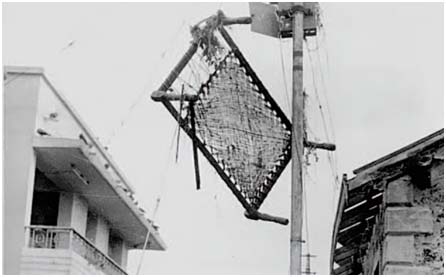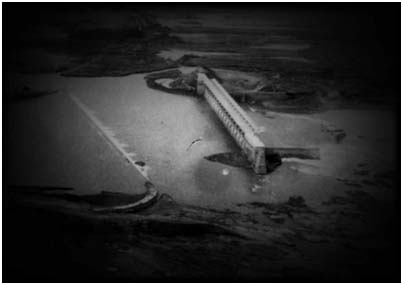A discussion was organised on a new book by Tom Wooten and Utpal Sandesara - "No one had a tongue to speak" that spectacularly reconstructs the 1979 Machhu dam disaster in Gujarat, one of history’s worst disasters. The meeting was organised by SANDRP at India International Centre, New Delhi on 30th July, 2012. The authors began their work in 2004 and uncovered critical facts that have long remained hidden from the public. They were able to write a complete history of the disaster based on 148 interviews of flood survivors, relief workers and government officials and perusal of thousands of pages of government documents.
The book reveals that the flood resulted from large-scale government design failures rather than from mismanagement by dam workers. The book also reveals how the government of Gujarat quashed a commission of inquiry set up to investigate the disaster so that embarrassing facts would not become public. It also tells the stories of those who lived through the disaster, and have remained neglected for more than thirty years.

Image courtesy: www.tomwooten.com
Paul Farmer in the foreword to the book notes that “the topic has generated a varied literature, from the first-person testimonial to scholarly histories, and “No one had a tongue to speak” sits quite comfortably in between these genres.
According to Sandesara, “the dam collapse is one of the worst environmental disasters in history, and no one has heard about it. This book is an attempt to tell the story of a place, a monsoon, the government cover-up that unjustly silenced the narrative for too long, and—most importantly—the people who experienced this incredible suffering, and their resilience.”
The present Chief Minister of Gujarat, who had himself volunteered in Morbi after the flood, granted the authors first-time access to classified technical reports and photographs. Wooten analyzing the causes of the floods says “it’s like a bathtub with a clogged drain and the faucet on—eventually water would wash over the top. Unfortunately, the top of this bathtub was made of dirt.”
Story of Machhu dam disaster
The book for the first time brings the true causes of the flood into public light. Not many of us know that on August 11, 1979, the four-kilometer long dam (Machhu Dam-II) on the Machhu river in Gujarat collapsed leading to a deluge in the industrial city of Morbi located five kilometers downstream and the surrounding rural areas that destroyed thousands of homes and lives.
This devastating flood occurred in the wake of ten days of persistent rainfall when the dam’s floodgates wrongly designed for passage of 220,000 cusecs of water received an inflow of 400,000 cusecs. The earthen dam overtopped and collapsed. Within 20 minutes floods of 12 to 30 ft height inundated the low-lying areas of Morbi town. The book reveals how the dam authorities had been ignoring repeated warnings from the central authorities regarding the calculation of maximum flood.

Image courtesy: www.thefloodbook.com
The final death count is estimated to be between 5,000 and 10,000. The authors note that the collapse was “neither an “act of God”- as the government claimed—nor a failure in management by dam workers—as most citizens of Morbi believe to this day- but rather a severe failure of both engineering and oversight”. The book says that the death toll was phenomenally high because of systematic communication failures.

Image courtesy: www.thefloodbook.com
Tragic tale of the Commission of Inquiry
“No one had a tongue to speak” outlines revelations about government failures before and after the Machhu dam disaster. It details the heartrending account of the independent judicial Commission of Inquiry set up by the State Government, which for a year and half investigated into the technical causes of the dam’s failure and on the adequacy of the efforts of the dam authorities to warn people downstream of the imminent danger. It also shows how when the investigation zeroed in on flawed design practices in the Irrigation Department, Mr. Madhavsinh Solanki, the Chief Minister at the time of submission of inquiry report wound up the Commission midway.
Machhu dam-II was rebuilt in the end of the 1980s. Sandesara in an interview says that “a public interest group sued the government on behalf of the people and won a judgment in the Gujarat High Court, but the Supreme Court overturned the ruling, ensuring that the full lessons of the Machhu dam disaster would not come to public light.”

Image courtesy: www.thefloodbook.com
Experiences of those who lived the disaster
The book through vivid first person accounts exposes the systematic injustices surrounding the flood. People scrambled for rooftops, hilltops, and other safe grounds in order to save themselves. At the Vajepar Ram Mandir, over a hundred people breathed their last when the deluge submerged the temple. Women were compelled to drop their babies into the furious surge in order to save themselves and people lost their loved ones in a flash.
The book also presents incredible narratives of survival like that of a “woman, paralyzed from the waist down, who floated above the waves in a wash basin. Mr. Gangaram Tapu, an able-bodied young prisoner at the local jail, swam through the torrent and pulled dozens of people to safety; he would earn a pardon, only to return to jail twenty-five years later.”
The heroic effort of volunteers, government officials, and ordinary citizens following the flood is described. The book also deals with the efforts of the then Chief Minister Mr. Babubhai Patel, who along with his cabinet camped at Morbi, in an effort to bring the city back to normal. The book gives an account of the remarkable work done by Mr. A.R. Banerji, the then Rajkot District Collector in coordination of immediate relief work has been detailed. He however lost his position subsequently for writing a damning report about the government’s handling of the flood. This report was not put in the public domain.
The Machhu Dam disaster offers a cautionary tale regarding the dangers of massive development undertaken without foresight or precaution, the authors conclude.
For information on the book, see: http://thefloodbook.com